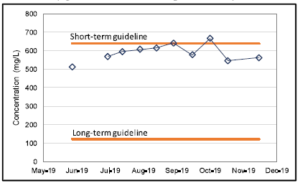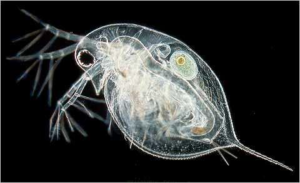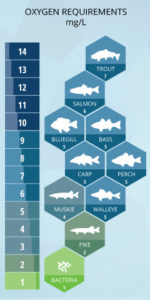The original design of Swan Lake included environmental elements to support a healthy fish habitat.
Early reports cite Swan Lake as supporting pumpkinseed sunfish, fathead minnows and largemouth bass (believed to have been stocked prior to 1992 by TRCA). Many fish died prior to the Phoslock treatment in 2013.
Establishing a healthy aquatic environment for Swan Lake means addressing two key issues: 1) excessive levels of chloride (road salt); and 2) improving the low levels of dissolved oxygen.
The following charts provided by Markham Environmental Services illustrate that the average annual chloride level in Swan Lake in 2019 was 5x the long term Canadian Water Quality Guidelines for the Protection of Aquatic Life – Chloride of 120 mg/L and that each month in 2019 the chloride levels approached or exceeded the short-term guideline of 640 mg/L.
 |
 |
| Short-term Levels of Chloride 2019 | Average Annual Levels of Chloride |
The observed levels of chloride in Swan Lake in 2019 are well in excess of a safe environment for 44% of the species on which the federal guidelines were based, including small fish such as the Fathead Minnow, which was identified as an original species in Swan Lake.
Researchers have concluded that the federal environmental guidelines for chloride are too high to adequately protect zooplankton communities. Up to 70% of the zooplankton cannot survive at guideline levels. In 2019, the chloride levels in Swan Lake were 5x higher than the federal guidelines.
 |
Zooplankton is a beneficial element in freshwater because it consumes phytoplankton (microscopic algae and microbes).
A healthy zooplankton colony would be an important contributor to controlling algal growth in Swan Lake but the high levels of chloride is undermining the existence of zooplankton in Swan Lake. |
The levels of dissolved oxygen in Swan Lake are typically below 3 mg/L. Only the hardiest of fish can survive at such low levels. Current sightings report carp, goldfish, catfish and minnows.
A program to control phosphorus levels in Swan Lake must also restore dissolved oxygen levels in order to support a return to a balance aquatic environment.
 |
In June 2020, city staff asked Council to approve a Fish Management program focused on eliminating the troublesome bottom feeding goldfish and catfish that stir up the phosphorus laden sediments at the bottom of the Lake.
The Friends of Swan Lake Park have asked the City to take a broader perspective and engage a fish specialist to advise on the type of fish that should be considered for restocking and to develop a long term Fish Management Program for the Swan Lake. The city’s water consultant has suggested that species selected should be ones that will assist in reducing algae levels in the lake, as opposed to bottom feeders such as carp and goldfish that stir up the bottom sediment and recycle the dormant phosphorus. Other species recommended prey on mosquito larvae, thereby reducing mosquitos. |
Source: Fondriest Environmental Learning Center
www.fondriest.com

